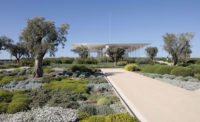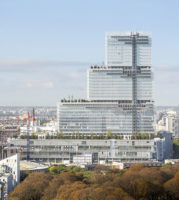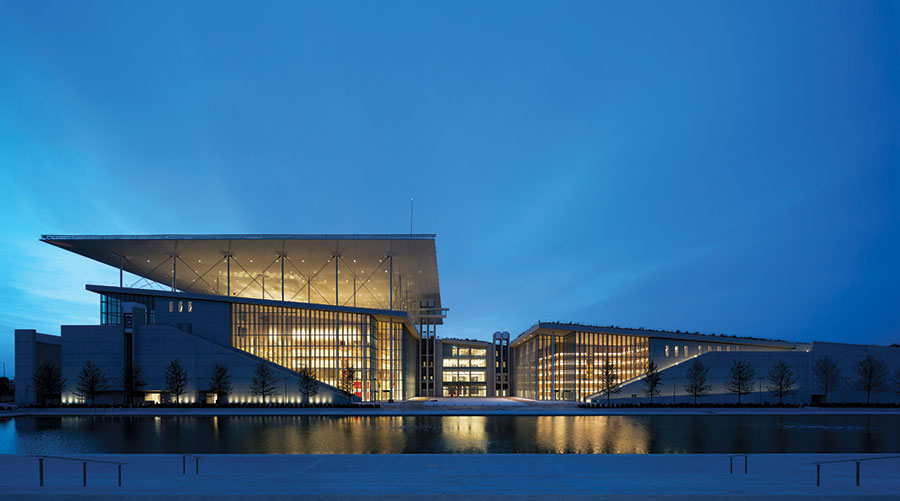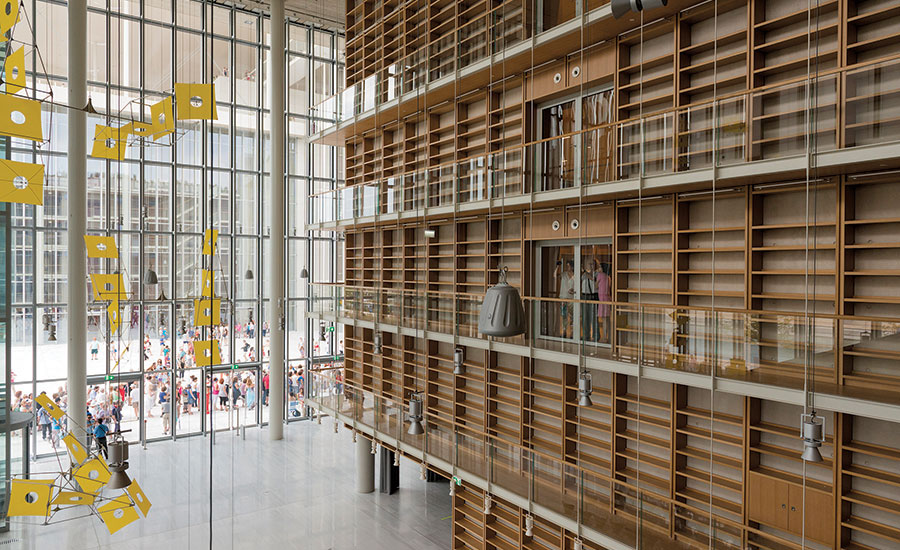Stavros Niarchos Foundation Cultural Center by Renzo Piano Building Workshop
Athens

The opera house and the National Library are separated by a spacious agora and bounded by a 1,300-foot-long reflecting canal.
Photo © Michael Denancé

Close to a bay and to the 2004 Olympic Stadium, the complex has a green roof that can be reached by steps.
Photo © Michael Denancé

Close to a bay and to the 2004 Olympic Stadium, the complex has a green roof that can be reached by steps.
Image courtesy RPBW

An early Piano sketch shows the primacy of the canal as a unifying element.
Image courtesy RPBW

The elegant 1,400-seat horseshoe-shaped auditorium can be acoustically adjusted with specialized curtains.
Photo © George Dimitrakopoulous / SNFCC

The lobbies of the opera house and library, with its currently empty shelves, signal their respective functions through the glass-fin walls surrounding the agora. The hanging mobiles are by Susumu Shingu.
Photo © Yiorgis Yerolymbos / SNFCC

The lobbies of the opera house and library, with its currently empty shelves, signal their respective functions through the glass-fin walls surrounding the agora. The hanging mobiles are by Susumu Shingu.
Photo © Shunji Ishida / RPBW

The opera house roof under a ferro-cement canopy offers spectacular views of the city and the Acropolis, while a glazed viewing space cantilevers above the complex.
Photo courtesy SNFCC

The opera house roof under a ferro-cement canopy offers spectacular views of the city and the Acropolis, while a glazed viewing space cantilevers above the complex.
Photo © Yiorgis Yerolymbos/SNFCC

The four-day public opening in June drew 115,000 people.
Photo © Yiorgis Yerolymbos / SNFCC

The 42-acre park, the largest in Athens, features native plants and slopes gently upward to cover the library with a green roof. It is targeted to be the first LEED Platinum project in Greece.
Photo © Michael Denancé

Image courtesy RPBW

Image courtesy RPBW

Image courtesy RPBW














Architects & Firms
Experimentation with forms, materials, and means of sustainability has been a constant throughout Renzo Piano’s career. For the Stavros Niarchos Foundation Cultural Center (SNFCC) in Athens, he pushed the envelope of all three, and the result is a stunning hilltop complex that includes an opera house, a new home for the National Library of Greece, and a 42-acre park.
The building is composed of two large volumes, separated by a spacious open-air agora, that sit on a structure of reinforced concrete with some steel elements. All of this is embedded in a 100-foot-high man-made hill, which provides dramatic views of the sea and the city. Piano, who was chosen in 2008, replaced the master plan by Cooper Robertson, which had left the site flat, with his own scheme, literally bringing a new dimension to the project. The architect referenced the nearby mountains and their marble quarries in creating the artificial hill, and then excavated it deeply to insert the structure.
The official opening awaits the library’s transfer of its fabulous collection, which, in addition to nearly 2 million books and periodicals, includes 9th- and 10th-century parchment manuscripts as well as the 13th-century one that was the first in the Byzantine and Mediterranean world to replace parchment with paper. In the meantime, completion of construction was celebrated in June with four days of free festivities that attracted 115,000 people. The event provided a brief respite from the six years of painful austerity suffered by Greece in order to qualify for the $300 billion bailout by the European Union. The festival’s title, Metamorphosis: the SNFCC to the World, reflects the conviction of Andreas Dracopoulos, copresident and director of the Stavros Niarchos Foundation (SNF)—which made the prodigious gift to Greece—that the new complex symbolizes the nation’s transformative capabilities.
The cultural center is in the middle-class Kallithea neighborhood, just two miles south of the Acropolis and only a few hundred feet from scenic Faliro Bay. Except for the opera and some library services, the facility will be open to the public gratis. Among its public amenities is a new 42-acre park with a large lawn that can be used for art installations, and nine playgrounds, designed by Deborah Nevins & Associates of New York; it features drought-resistant Mediterranean vegetation and covers most of the site, climbing up the hill and onto the library’s green roof.
Signaling the complex’s presence—and clearly visible from the surroundings—is a huge but seemingly weightless 107,600-square-foot white canopy, tapered like an airplane wing, which floats above the opera house. Created with Expedition Engineering, the British firm that also executed the seismically resistant structure, it is made of ferro-cement, a thin shell of reinforced mortar over a layer of metal mesh and closely spaced steel rods. Low wages in Greece and generous funds from the SNF enabled the fabrication of this material, ruled out in any significant quantity in developed countries since the 1950s because of its labor intensity. The canopy not only supplies shade but also supports solar panels (one of many factors behind the project’s targeted LEED Platinum designation, which would be a first in Greece).
Below the canopy on the opera house roof, a vast, outdoor terrace is the most spectacular of the complex’s numerous public spaces. Accessed by two dedicated glass elevators as well as by an uphill path through the park, this high point offers panoramic views of the sea, the Acropolis, and the surrounding city, while capturing welcome breezes. At ground level, a 1,300-foot-long, 100-foot-wide canal reinforces the relationship with the sea. Seeming to extend to infinity, the ribbon of water reflects the entire length of the complex and visually ties together its components. Beside the channel, a broad promenade, lined with plane trees, leads to the agora.
From the agora, looking into the towering, clear-glass-fin walls, the program within each wing is visible: broad balconies identify the opera house and multiple levels of bookshelves call out the library. The 80-foot-high, narrow opera house lobby (with a box office, coat room, and bar) bustled with crowds during the June festivities. The flawless poured-in-place concrete of the walls here and the perfect alignment of the marble floor slabs are among many examples of the extraordinarily high quality of workmanship throughout the complex.
Across the agora from the opera house is a public lending library, combined for the first time with the scholarly National Library. Each has generous spaces, many filled with natural light. Numerous colorful seating arrangements invite social exchange and visitors with laptops. However, with little tradition of library usage in Greece, these expansive spaces may initially exceed demand.
In the entranceways to both wings, balconies suspended from the ceiling are fabricated in the same materials: white-painted steel, glass balustrades, and oak handrails, floors, and ceilings. Animating both lofty spaces are brightly colored paper mobiles by the Japanese artist Susumu Shingu and “Perroquet” aluminum light fixtures by Renzo Piano Building Workshop (RPBW), which are white at the opera, and gray at the library.
In the opera house, the lobby’s informality gives way to the plush elegance of a traditional 1,400 seat auditorium. The curved walls are clad in deep-red-stained anigré veneer, and balcony fronts are natural American cherry; seats sport a brighter red fabric. (There is also a more modern-looking 450-seat experimental theater located at the southern side of the main auditorium.) Judging by a recent performance with piano accompaniment of Cellia Costea’s “Vissi d’Arte” from Tosca, the theater’s acoustics are excellent. RPBW’s first opera house design promises to be a smashing success.
In 2007, the SNF responded to the Greek government’s call for a new home for the opera and the National Library by promising to assume all design and construction costs, which totaled nearly $842 million. In 2009, despite the nation’s worsening financial situation, the foundation confirmed its commitment with the understanding that, when completed, the complex would be handed over to the Greek government, which would own and run it (at an annual cost at present of approximately $40 million). Now, eight administrations later, with the possibility that the government may be unable to assume this financial responsibility, the SNF might temporarily pick up the tab. In addition to the SNFCC’s aesthetic and practical merits, it is undoubtedly an inspiring symbol of belief in the future of Greece.
PeopleArchitect: Renzo Piano Building Workshop, in collaboration with Betaplan (Athens) — G.Bianchi, partner in charge; V. Laffineur, associate in charge, designteam Engineers: Expedition Engineering/OMETE (structural); Arup/LDK Consultants (m/e/p, sustainability, acoustics, lighting, security, IT); Theater Project Consultants (theater equipment); Front (facade) Consultants: Deborah Nevins & Associates/H.Pangalou (landscaping); C&G Partners, M. Harlé/J. Cottencin (signage); Faithful+Gould (project and cost management) General Contractor: Salini Impregilo Terna Client: Stavros Niarchos Foundation Size: 950,000 square feet (building) Cost: $842 million Completion date: June 2016
|
ProductsConcrete ET Beton, Lafarge Metal / Glass Curtain Wall Unifor, Tosoni Glass Saint-Gobain, AGC, Guardian Skylights Schüco Lighting Zumtobel, Artemide, Luceplan, iGuzzini, ERCO, Bright, Ares, SILL Lighting, Bruck Lighting, ETAP Lighting, Reggiani, Luxo |




















